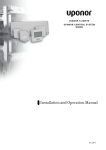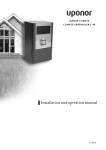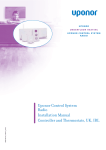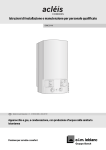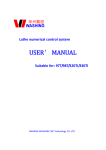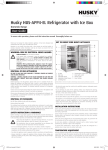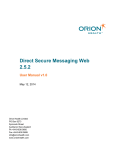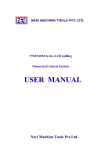Download Uponor UponorControl System Installation manual
Transcript
UPONOR U N D E R F LO O R H E AT I N G UPONOR CONTROL SYSTEM WIRED 9416-121-00 / IOM- V_07-02 Uponor Control System, Wired Installation Manual, UK, IRL Livre_R3_IM.indb 21 14/03/2007 12:03:16 In keeping with our policy of continuous improvement and development, Uponor reserves the right to change specifications without prior notice. Uponor Hou s i n g S o l u t i o n s Lt d . Snapethorpe H o u s e Rugby Road Lutter wor th Leicestershire LE17 4HN T F W E Uponor Cen t ra l E u ro p e PO Box 1641 ( I n d u s t r i e s t ra s s e 5 6 ) D-97433 Has s f u r t T +49 (0)9521 690 0 F + 4 9 ( 0 ) 9 5 2 1 6 9 0 1 5 0 W w w w. u p o n o r. d e Uponor Nord i c PO Box 101 SE-730 61 V i r s b o T +46 223 380 00 F + 4 6 2 2 3 3 8 1 0 1 HS South, We s t Area manage m e n t Uponor Hisp a n i a S . A . U . Calle C , n° 2 4 Polígono Ind u s t r i a l n ° 1 E-28938 Mós to l e s ( M a d r i d ) T +34 91 685 3600 F + 3 4 9 1 6 4 7 3 2 4 5 W w w w. u p o n o r. e s Uponor Cor p o ra t i o n Rober t Hube r i n t i e 3 b P.O. Box 37 FI-01511 VA N TA A T +358 (0)20 129 211 F + 3 5 8 ( 0 ) 2 0 1 2 9 2 8 4 1 Livre_R3_IM.indb 22 +44 (0)1455 550355 +44 (0)1455 550366 w w w. u p o n o r h o u s i n g s o l u t i o n s . co . u k h s e n q u i r i e s @ u p o n o r. co . u k 14/03/2007 12:03:16 INSTALLATION_MANUAL_R3-04A.mif Page 3 Mercredi, 14. mars 2007 11:34 11 Table of contents 1. General recommendations ................................................................................................................................ 4 2. The Uponor Control System .............................................................................................................................. 5 2.1 Example of a system...................................................................................................................................... 5 2.2 Uponor Control System components................................................................................................................. 5 3. Installation ....................................................................................................................................................... 6 3.1 Preparation before installation ......................................................................................................................... 6 3.2 Installation of the components ........................................................................................................................ 6 3.3 Connections.................................................................................................................................................. 7 3.3.1 Controller description ....................................................................................................................... 7 3.3.2 Connect the actuators to the controller ............................................................................................... 7 3.3.3 Controller wiring .............................................................................................................................. 8 3.3.4 Installation of the options................................................................................................................ 11 3.3.5 Connecting the controller to the mains .............................................................................................. 12 3.4 Thermostats ............................................................................................................................................... 13 3.4.1 Opening the thermostats................................................................................................................. 13 3.4.2 Mounting and wiring the thermostats ................................................................................................ 13 3.4.3 Thermostat setup........................................................................................................................... 14 3.5 Thermostat option ....................................................................................................................................... 14 3.5.1 Introduction .................................................................................................................................. 14 3.5.2 Wiring and setting the floor sensor potentiometer............................................................................... 14 4. Finishing the installation ................................................................................................................................ 15 5. System maintenance ...................................................................................................................................... 15 5.1 Controller current limitation .......................................................................................................................... 15 5.2 Actuator's behavior...................................................................................................................................... 15 5.3 Fallback mode............................................................................................................................................. 15 5.4 Automatic exercise function .......................................................................................................................... 15 5.5 Resetting Installation ................................................................................................................................... 15 6. Troubleshooting ............................................................................................................................................. 16 7. Installation report ...................................................................................................................................fold-out 8. Technical data .........................................................................................................................................fold-out 9. Wiring diagram / Controller description ..................................................................................................fold-out Uponor Control System - Installation Manual 3 INSTALLATION_MANUAL_R3-04A.mif Page 4 Mercredi, 14. mars 2007 11:34 11 1. General recommendations Safety measures • Read and follow instructions. Power supply WARNING • Installation must be performed by a qualified person according to local regulations. • The Uponor Control System uses a 230VAC 50Hz power supply. • It is prohibited to make changes or modifications not specified in this manual. • In case of emergency, immediately disconnect the plug from the 230V mains. • Power must be switched off when carrying out the wiring. • Do not use water to clean the Uponor Control System. • We decline any responsibility concerning damages and breakdowns that may result from the non-observance of these instructions. • Do not expose the Uponor Control System to flammable vapors or gases. Symbols used in this manual WARNING Risk of bodily injuries or squeezing. Non observance may harm health or cause damage to product components. STOP CAUTION Important note on functionality. Non observance of this note may cause malfunctions. Technical constraints • Keep installation/data cables away from power cables > 50V to avoid interference. • The electrical circuits of the boiler and the pump must be protected by a maximum 6A circuit-breaker. Information Important operating advice and information. See another document. 99 See another page in the manual. Heating/cooling. Timer. 4 Underfloor Heating INSTALLATION_MANUAL_R3-04A.mif Page 5 Mercredi, 14. mars 2007 11:34 11 2. The Uponor Control System The Uponor Control System is a complete management for underfloor heating systems. Comfort, user-friendliness and temperature control for each individual room of your home can be combined through the use of thermostats or floor temperature sensors. 2.2 Uponor Control System components For an optimal setting of the system see Operation Manual. 2.1 Example of a system The Uponor Control System consists of thermostats, a controller and actuators. The controller manages the operation of the actuator when the thermostats detect a demand for heating or cooling. The Uponor Control System may be controlled with the help of three types of thermostats. Designed for maximum comfort, the thermostats communicate with the controller by non polarized two wired system. Don't "U-link" the outputs! It's automatic. One thermostat controls the following AC output if no thermostat is connected there, and so on. It's possible to use all kinds of Uponor Control System wired thermostats in the same system. Uponor designation Item Description Uponor Controller Uponor Thermostat T-35 Uponor Thermostat T-37 Uponor Thermostat T-33 1 6 or 12-channel controller 2 Fastening screws 3 Installation and Operation Manual 2 Fastening screws 4 Thermostat 2 Fastening screws 5 Thermostat for floor sensor 2 Fastening screws 6 Thermostat Public Uponor Floor sensor Uponor Relay Uponor Description Mark 1 Timer 7 Floor sensor for Thermostat Public T-33 and Thermostat T-37 (option) 8 Heating / cooling relay (option) 9 Timer (option) Thermostat T-35 2 Thermostat Public T-33 (with the option of adding a floor sensor option) 3 Thermostat T-37 (with the option of adding a floor sensor option) 4 Controller, 6-channel (C-33) or 12-channel (C-35) The floor sensor can be used for maximum or minimum limitation of the floor temperature, regardless of the room temperature. It can only be used with the Thermostat Public T-33 and Thermostat T-37. For example, the maximum limitation can protect a sensitive floor covering from exposure to too high temperature when there is a high heat demand. The minimum limitation can keep a tiled floor warm even when there is a no general demand for heat supply to the room. Uponor Control System - Installation Manual 5 INSTALLATION_MANUAL_R3-04A.mif Page 6 Mercredi, 14. mars 2007 11:34 11 3. Installation Installation steps 3.2 Uponor recommends that you follow the steps described below to guarantee the best possible installation: Mounting the controller (6 or 12-channel) Description Installation of the components 3.1 Preparation before installation • Check that the cover of the controller can easily be removed. 3.2 Installation of the components (controller and thermostats) 3.3 Connections (thermostats and actuators to controller) • Check that the connectors and switches are easily accessible. 3.4 Room thermostats 3.5 Floor sensor thermostats 4 Finishing the installation 3.1 STOP The controller has to be mounted horizontally. There is a risk for overheating if the controller is mounted vertically or on a horizontal surface. Preparation before installation Before beginning the installation: • Verify the contents of the package with the list shown in Section 2 to make sure you have all the necessary products; • Check whether a floor sensor has been mounted; • Study the wiring diagram in the fold-out or inside the controller cover. • A controller should be installed close to each manifold; • A power outlet is required for the connection of the controller to the mains; • The mounting locations for the Uponor Control System must be protected from running and dripping water; • Put one thermostat for every room fitted with a heating floor (one thermostat can control several loops of the heating floor). 6 1 Drill the wall (Ø6 mm) 2 Press the anchor into the hole (if concrete wall) 3 Attach the controller to the wall with screws Underfloor Heating INSTALLATION_MANUAL_R3-04A.mif Page 7 Mercredi, 14. mars 2007 11:34 11 3.3 Connections 3.3.1 3.3.2 Controller description 99 99 See controller picture in fold-out. 6-channel controller See wiring diagram in the fold-out. There are two non-polarized wires to connect the thermostat. Example of an installation: Description Mark Connect the actuators to the controller 1 Quick connector for 8 actuators 2 Power LED 3 230VAC 50Hz compartment 4 Quick connector for 6 thermostats All actuators of a group are controlled by the thermostat connected to the first actuator. Do not "U-Link" with wire. The linking is automatic. The first thermostat controls all following AC output (actuators) if no thermostat is added there. One thermostat can control the whole controller (14 outputs). In this example, thermostat #01 controls the actuators on terminals 1 to 4. Thermostat #05 controls the actuator on channel 05 and also controls channels 06 to 11 when no additional thermostat is linked to 06 to 11. 12-channel controller Mark Description 1 Quick connector for heating / cooling relay 2 Quick connector for timer 3 Quick connector for Condense sensor 4 Quick connector for 14 actuators 5 Bi-color power LED (red for Heating mode and green for Heating / Cooling mode) 6 Push-button for Heating or Heating / Cooling mode 7 230VAC 50Hz compartment 8 Quick connector for 12 thermostats Uponor Control System - Installation Manual In the following example, thermostat #03 is added, it controls the actuator on channel 03 and also control channel 04. Thermostat #01 controls actuators on channels 01a and 01b and channels 02a and 02b. 7 INSTALLATION_MANUAL_R3-04A.mif Page 8 Mercredi, 14. mars 2007 11:34 11 3.3.3 Controller wiring Thermostat quick connector on the 12-channel controller: One of the thermostat's two wires will always be connected to terminal 1 “Com” (non-polarized). Thermostat quick connector on the 6-channel controller: Thermostat connection without timer: Connect one wire of the thermostat to "com" and the other wire to 2. If there is a timer: Connect one wire of the thermostat to "com" and the other wire to 2 if the room requires no timer control. Or connect one wire to "Com" and the other wire to 3 (timer Zone 1) or 4 (timer Zone 2). See explanation on next page. Heating 8 1 Com 2 No timer control Heating Heating/cooling 1 Com Com 2 No timer control No timer control 3 Timer zone 1 Eco on: Timer control 4 Timer zone 2 Cool Off: No cooling for this room Underfloor Heating INSTALLATION_MANUAL_R3-04A.mif Page 9 Mercredi, 14. mars 2007 11:34 11 3.3.3.1 Connection without Timer option 3.3.3.2 Connection with Timer option in Heating only mode Connect thermostat and terminal: (Only 12-channel controller) "Com" and "No timer": The installation will work in a standard way with the thermostats regulating each room according to their set temperatures. Reduced mode is not available. To connect the timer, see the wiring diagram in the fold-out. One of the thermostat's two wires will always be connected to the “Com” quick connector and the second to one of the remaining three quick connectors, depending on the mode selected (non-polarized). Example of an installation wired without Timer: Connect thermostat and terminal: • "Com" and "No timer": The installation will work in a standard way with the thermostats regulating each room according to their set temperatures. • "Com" and "Zone 1" (allocate the thermostat to Zone 1): The corresponding channel will run in Comfort mode according to the time slots in Zone 1 of the timer. Example: Zone 1 (for settings see timer manual) Thermostat #01 controls the actuator on channels 01a and 01b and channels 02a and 02b. Thermostat #03 controls the actuator on channel 03 and controls channel 04. Thermostat #05 controls the actuator on channel 05 to channel 11. Thermostat #12 controls channel 12. COMF ECO night morning evening night • "Com" and "Zone 2" (allocate the thermostat to Zone 2): The corresponding channel will run in Comfort mode according to the time slots in Zone 2 of the timer. Example: Zone 2 (for settings see timer manual) COMF ECO night Uponor Control System - Installation Manual morning evening night 9 INSTALLATION_MANUAL_R3-04A.mif Page 10 Mercredi, 14. mars 2007 11:34 11 3.3.3.3 Connection with Timer option in Heating / Cooling mode To connect the timer, see the wiring diagram in the fold-out. • "Com" and "Cool Off": When the system is running in Heating mode: The corresponding channel will run in Comfort mode according to the time slots in Zone 1 of the timer. When the system is running in Cooling mode: There will be no cooling in the room allocated to this thermostat. Connect thermostat and terminal: • "Com" and "No timer": When the system is running in Heating mode: The installation will work in a standard way with the thermostats regulating each room according to their set temperatures. When the system is running in Cooling mode: The installation will work in a standard way with the thermostats regulating each room according to their set temperatures. • "Com" and Timer control: When the system is running in Heating mode: The corresponding channel will run in Comfort mode according to the time slots in Zone 1 of the timer. (for settings see timer manual) Zone 2 is not used in Heating mode when heating / cooling is active. One of the thermostat's two wires will always be connected to the “Com” quick connector and the second to one of the remaining three quick connectors, depending on the mode selected (non-polarized). Example of an installation wired with a timer: COMF ECO night morning evening night When the system is running in Cooling mode: In Cooling mode, Zone 1 and Zone 2 will be linked in a specific area: automatic overlap of Zone 1 and Zone 2 with specific period "ECO" and "Comfort". This process will take place automatically. The Zone 1 and 2 Comfort mode overrides the Eco mode. The corresponding channel will run in Comfort mode according to the time slots in the specific zone of the timer. This link also enables you to use your cooling unit during the night and to save energy when people are not at home. Thermostat #01 controls channels 01a, 01b, 02a and 02b in "Timer control" (Zone 1) if in Heating mode and "Cool Off" if in Cooling mode. The following thermostats controls its channels in "No timer" mode. Zone 1 COMF For more information about Comfort/Eco features, see the timer Manual. ECO Zone 2 For the 6-channel controller, the thermostat is directly connected to the terminals (non-polarized). Comfort/Eco features are not available. COMF ECO Specific COMF ECO night 10 morning evening night Underfloor Heating INSTALLATION_MANUAL_R3-04A.mif Page 11 Mercredi, 14. mars 2007 11:34 11 3.3.4 Installation of the options Different options can be added to the Uponor control system to enhance its features, optimize your comfort and save energy. WARNING Mains supply 230VAC 50Hz Disconnect the 230V mains before installing or changing the device wiring. 3.3.4.3 Controller heating / cooling input If your installation is equipped with a cooling unit, the Uponor control system can be run through a heating / cooling relay. The controller heating / cooling input operates with the connection of a dry contact. The contact's control can be either an additional regulation system or a two-position switch. STOP 3.3.4.1 Timer g The Uponor control system can be equipped with a timer to add energy-saving features and define independent zones. The timer has two programming zones. Each offers four programming options, including one that can be personalized, thus enabling different programmes to be created for each day of the week. 99 99 See "3.3.3.2 Connection with Timer option in Heating only mode" or "3.3.3.3 Connection with Timer option in Heating / Cooling mode", page 9, 10 for more information on wiring. Do not apply voltage to the heating / cooling contact. Damage to the Uponor Control System will occur. Connect the heating / cooling relay between terminals 11 and 12 of the controller (symbol ). Example of wiring: See wiring diagram in the fold-out. See the timer Manual for more information. The timer is not available for the 6-channel controller. 3.3.4.2 Floor sensor The floor sensor can be used for maximum or minimum limitation of the floor temperature, regardless of the room temperature. It can only be used with the Thermostat Public T-33 and Thermostat T-37. For example, the maximum limitation can protect a sensitive floor covering from exposure to too high temperature when there is a high heat demand. The minimum limitation can keep a tiled floor warm even when there is a no general demand for heat supply to the room. The minimum limitation should not be set to a value higher than the required room temperature. 99 See "3.5 Thermostat option", page 14 for more information on wiring and setting. See the floor sensor Manual for more information. Uponor Control System - Installation Manual 1 Heating / cooling relay 2 Heating / cooling contact 3 Controller heating / cooling input 4 Example of a different type of heating / cooling relay command To configure the controller in Heating / Cooling mode, press the push-button on the controller to switch between modes: • The LED is red for Heating mode. • The LED is green for Heating / Cooling mode. Heating / Cooling mode is not available for the 6-channel controller. 11 INSTALLATION_MANUAL_R3-04A.mif Page 12 Mercredi, 14. mars 2007 11:34 11 3.3.4.4 Circulation pump relay 3.3.5 Connecting the controller to the mains 1 Check that the wiring is complete (actuators, thermostats, pump, timer) 2 Check that the 230V compartment is closed 3 Connect the plug to the mains The Uponor Control System can operate a circulation pump on heating/cooling demand. The pump will stop when there is no heat or cooling demand. Example of an installation: WARNING See the circulation pump supplier documentation before performing the connection. The controller controls the circulation pump via connection on terminal block (dry contact). There is no power for the pump in the box, just the dry contact. The electrical circuits of the pump must be protected by a maximum 6A circuit-breaker. 1 Ensure the power is disconnected 2 Open 230V compartment and fix cover to hanger 3 Connect "L" wire from/to pump via relay 4 Close 230V compartment The pump runs when at least one actuator is active. During actuator exercise, the pump continues to work normally. 12 Underfloor Heating INSTALLATION_MANUAL_R3-04A.mif Page 13 Mercredi, 14. mars 2007 11:34 11 3.4 Thermostats The Uponor Control System may be controlled with three types of thermostats. • Thermostat T-35 wired: Adjust the temperature with the dial. The dial must be removed to set min/max on the thermostat. • Thermostat Public T-33 wired: The thermostat is designed for public location. The potentiometers used for the settings are protected with a cover. This thermostat also can be used to connect a floor sensor option. • Thermostat T-37 wired for floor sensor: Adjust the temperature with the dial. The potentiometers used for the settings are protected with a cover. The dial and the cover must be removed to set up min/max on the thermostat. This thermostat also can be used to connect a floor sensor option. 3.4.1 3.4.2 Mounting and wiring the thermostats 3.4.2.1 Location of a thermostat (For all thermostats) • On an indoor wall. • 1.5 m to 1.8 m from the floor. • Away from any source of humidity. (IP20) • Away from any source of heat (television, electronic equipment, fireplace...). • Away from direct solar radiation. • Away from direct water splashes. Opening the thermostats 3.4.2.2 Thermostat fixation Fixing on the wall: Drill the wall (Ø6 mm). Fix anchors in the wall. Let the screw protrude from the box (3 mm). Screw the thermostats on the wall or/and on the box. Uponor Control System - Installation Manual 13 INSTALLATION_MANUAL_R3-04A.mif Page 14 Mercredi, 14. mars 2007 11:34 11 3.4.2.3 Thermostat wiring 3.5 Connect the cable from the controller (non-polarized) Thermostat option Open the thermostat cover: see "3.4 Thermostats", page: 13. 3.5.1 Introduction Thermostat Public T-33 and Thermostat T-37 allow a floor sensor to be fitted to the system. The temperatures thus measured ensure a more efficient management of the system. 3.5.2 Wiring and setting the floor sensor potentiometer When a floor sensor is connected to the thermostat to control the temperature of the floor, the limitation of the floor temperature can be adjusted with a potentiometer. The floor sensor settings override the thermostat. Settings: • Minimum range: 5°C to 35°C. • Maximum range: 30°C to 40°C 99 3.4.3 See: "3.3.3 Controller wiring", page: 8 Thermostat setup See Operation Manual for thermostat min/max and room temperature settings. 99 For more information on external sensor settings: See "3.5 Thermostat option". 1 14 Select the required temperature using the potentiometer Underfloor Heating INSTALLATION_MANUAL_R3-04A.mif Page 15 Mercredi, 14. mars 2007 11:34 11 4. Finishing the installation 5. System maintenance 5.1 Controller current limitation To avoid risk of current overload, the controller uses a protection system: At start-up, 14 actuators cannot be open at the same time. During application, 14 actuators can work at the same time. The controller opens the maximum actuators according to the current limitation. 5.2 Actuator's behavior The normal position of an actuator is closed. The controller commands only the opening of an actuator. 5.3 Make a complete check up of the installation: • Verify that the thermostat covers are in place 1 2 • Check that the thermostats are working correctly (turn thermostat dial to obtain a heating demand and make sure that the actuators are running) Close the cover of the controller Close the thermostat covers where necessary 3 Fill in the "Installation report" on the centre pages of booklet 4 Give the manual and all information about the system to the users Fallback mode If a thermostat is short-circuited or not detected, the controller executes the Fallback mode: 7 min open, 14 min closed to maintain the temperature in the room (heating or cooling) until the problem is resolved. If the wire is broken, precedent thermostat will take the command or else Fallback mode is active. 5.4 Automatic exercise function The actuators and the pump are designed to avoid seizing, thereby increasing the reliability of the equipment. This exercise is done every 6 days +/- 0-24 hours at random: Exercise pump and actuators. The pump exercise operates only if the pump has not been activated since the last exercise. The pump is activated 3 minutes during the exercise. The actuators exercise operates only if the actuators have not been activated since the last exercise. The exercise consists of opening and completely closing the actuator. • 5 minutes to open an actuator. • 9 minutes to close an actuator. 5.5 Resetting Installation To reset the Installation, disconnect and reconnect the controller to the mains. Uponor Control System - Installation Manual 15 INSTALLATION_MANUAL_R3-04A.mif Page 16 Mercredi, 14. mars 2007 11:34 11 6. Troubleshooting Normal system operating conditions: The Power LED of the controller is lit up. The actuators are activated if there is demand for heating or cooling. Failure Causes Indication ■ room too cold (or too warm in Cooling mode) * Note the wiring thermostat is connected on a bad channel Solutions see Installation report and check ■ the LED of the thermostat does not switch on or off with heating or cooling demand actuator does not open the white indication can not be seen in the indicator window the thermostat is out of ■ measure the outputs if 24V when heat demand see Installation report and check ■ the LED of the thermostat does not switch on or off with heating or cooling demand too cold in Heating mode) * ■ the wiring thermostat is connected on a bad channel replace the actuator replace the thermostat order room too warm (or ■ actuator does not close the corresponding loop is warm even ■ correctly mounted after a long period without heat call ■ the thermostat is out of check that the actuator is replace the actuator replace the thermostat order ■ no heat demand (from underfloor heating system) ■ the room is heated by another heat source the floor is cold ■ The supply water is too room temperature OK, but the floor is cold hot. This causes a hot floor for a short while, followed by a cold, uncomfortable floor ■ check that the controller is connected to the mains and that the system does no voltage the wiring in the 230V power LED off in controller not start compartment is OK ■ check the circuit-breaker in the principal electrical board cable breakdown the thermostat is problem with a terminal not supplied block cable breakdown 230V in socket but not in 230V compartment the LED of the thermostat does not switch on or off with heating or replace cable and plug check the terminal cooling demand the LED of the thermostat does not switch on or off with heating or replace cable cooling demand the thermostat is out of order *: 16 replace the thermostat To find out if a problem is caused by the supply system or the control system. Check the temperatures of the flow and return pipes for the loop(s) corresponding to the room. Loosen the corresponding actuator(s) from the manifold. If the loop temperature starts to rise after a short while (a few minutes for the flow and longer for the return pipe, depending on the floor type), the problem is most likely caused by the room control system. If the temperature remains the same, the problem is in the system (hydraulic). Underfloor Heating
















